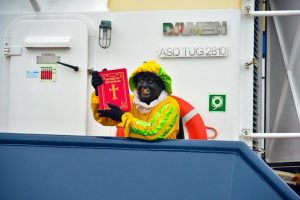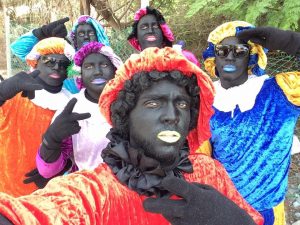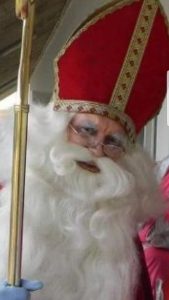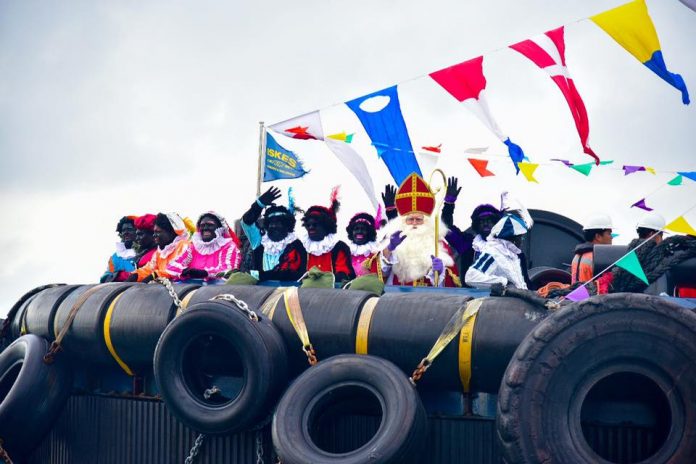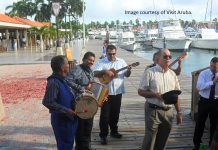It’s the time of the year again all the children of Aruba haven been waiting for. The arrival of Sinterklaas, November 17th. The holy man coming all the way from Spain bringing gifts for all the good children of Aruba. It surely is an exciting time for the kids.
Based on St. Nicolas, the patron saint of children, Sinterklaas (the name is a contraction of Sint Nikolaas) is a legendary Christmas figure celebrated in the Netherlands. Although similar to Santa Claus in that he is an older man with a full, white beard who wears red, Sinterklaas is a more serious figure, donning a bishop’s headdress and carrying a long, curled shepherd’s staff.
The Dutch celebrate the Feast of Sinterklaas honoring the life of St. Nicholas, and although St. Nicholas is always shown wearing his bishop’s attire, the Dutch tend to see him as a kindly old man, rather than as a Catholic saint. The result is that Sinterklaas is celebrated by Dutch people of all ages and beliefs, without any real religious connotations.
The Feast of Sinterklaas.
This real-life Santa Claus was born to wealthy parents in the third century in Patara (the area was Greek at the time, but is now part of Turkey). He spent his life giving away his money to the poor and doing good deeds. He died on December 6th, and it is this date that is commemorated—the Feast of Sinterklaas is held on Dec. 5th and 6th. The holiday, consisting of St. Nicholas’s Eve and St. Nicholas’s Day, is observed by exchanging gifts and chocolate letters (of the recipient’s initial). It is also customary to make good-natured fun of your loved ones, by way of humorous poetry written by the giver, and offering the infamous “surprise,” which is a (homemade) gag gift that hides another present inside. In Holland, it is more common to give presents on Sinterklaas than at Christmas, which remains a day to spend with family and attend church. The feast is celebrated annually with the giving of gifts on St. Nicholas’ Eve (5 December) in the Netherlands and on the morning of 6 December, Saint Nicholas Day, in Belgium, Luxembourg and northern France (French Flanders, Lorraine and Artois). The tradition is also celebrated in territories of the former Dutch Empire, including Aruba, Bonaire, Curaçao and Suriname.
Zwarte Piet
Sinterklaas is assisted by many mischievous helpers with black faces and colourful Moorish dresses. These companions are called Zwarte Piet (“Black Pete”). Zwarte Piet first appeared in print as the nameless servant of Saint Nicholas in Sint-Nikolaas en zijn knecht (“St. Nicholas and His Servant/Apprentice”), published in 1850 by Amsterdam schoolteacher Jan Schenkman; however, the tradition appears to date back at least as far as the early 19th Century.[4]
Zwarte Piet’s colourful dress is based on 16th-century noble attire, with a ruff (lace collar) and a feathered cap. He is typically depicted carrying a bag which contains candy for the children. The Zwarte Pieten toss their candy around, a tradition supposedly originating in the story of Saint Nicholas saving three young girls from prostitution by tossing golden coins through their window at night to pay their dowries.
The Foods of Sinterklaas.
At the Feast of Sinterklaas, the Dutch indulge in a variety of sweets including cookies, candies, and bread. Traditional recipes are speculaas (spiced cookies), kruidnoten (mini spiced cookies, also called ginger nuts), pepernoten(small aniseed flavored honey cookies), taai-taai (aniseed and honey flavored figurines), almond filled pastries, chocolate letters, and duivekater (a festive sweet bread). Mulled wine, called bischopswijn, is also enjoyed.
Waving a Carrot.
Dutch children believe that Sinterklaas writes down whether they’ve been naughty or nice in his red book. Sinterklaas rides a white horse, and the children put carrots in their shoes for his horse, hoping St. Nicholas will exchange them for presents if they were good.
Sinterklaas Vs. Santa.
It is said that Sinterklaas was the precursor of Santa Claus. Historians believe that Dutch and German settlers took the tradition with them to America. There, his Catholic garb was gradually transformed into the jolly non-sectarian red suit with the white fur trim we are all so familiar with. Additionally, his lithe frame gave way to a well-padded potbelly, and his trusty white steed was traded in for a troupe of reindeer. Either way, both Sinterklaas and Santa Claus stand for the generosity of spirit and kindness to children.
Sinterklaas will be arriving in Aruba on Sunday November 17th 2019 at the Harbor Arena at 10 AM. He will continue in a caravan going down the L.G. Smith Boulevard till the Plaza Libertador Betico Croes where a big welcome party awaits. There will be lots of singing, dancing, storytelling, a show presented by Sinterklaas’ helpers and much much more. Come and enjoy a family day and let your children meet Sinterklaas and his Black Piets. q
